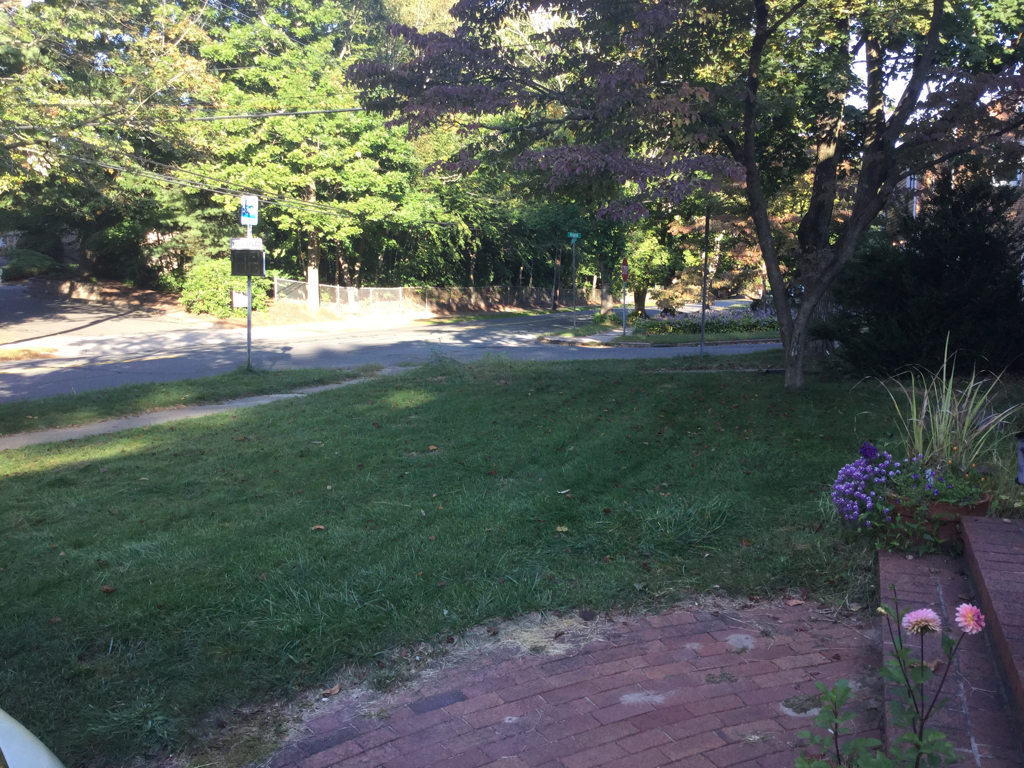|
A few nights ago, I visited the previous owners of this house in their new home. They want to move the butterfly bushes and a small tree from our yard into theirs, but have no idea where to put them, so they asked me to come take a look. It was the woman and her sister and they basically got a low-rent landscape design consultation plus an abbreviated version of the organic lawn talk I did last weekend.
The woman asked me what I planned to do with the yard, and something in me didn’t want to really tell her, but I’m glad I did. I said I planned to plant fruit trees and vegetables. Her face got serious. “I don’t know if you want to do that. My husband put a lot of nasty stuff down on that lawn.” “Like Weed and Feed?” “No, toxic stuff, like Grub-Ex.” I thanked her for telling me. I suppose I should find out exactly what went into that soil, though in the moment I really did not want to know. I’ll let the disappointment hit in small amounts, not all at once. I imagined there was nasty stuff in the soil, I just didn’t want to admit it. I have never seen a worm or grub or really anything in the soil. But I’m not going to let that stop me. I still fully intend to go through with my yard plan. I can’t accept a world where every suburban lawn is poisoned beyond use, just because it was once stewarded by some brainwashed person who knew nothing about plants. Plus, there’s no guarantee that the food we buy has been grown in pristine soil. Without researching anything, here’s what I know: —Fruit trees will probably be fine. Metals and toxins concentrate in the roots and leaves of plants more than in the fruits. This goes for vegetables as well. Fruiting vegetables are safer to plant in questionable areas than root or leaf crops. I will certainly not be planting vegetables soon, however. —Metals and chemicals have a harder time seeping into plants when the organic matter in the soil is high. This means adding manure, chopped leaves, compost, etc. —The UMASS toxic soil test I did in the spring revealed medium lead levels, and an arsenic reading of 15 in front, 5 in back. Research on this turned up inconclusive results. There is no national safe arsenic threshold; in some states it’s 2 and in some states it’s 40. Arsenic also leaches out of rock, so some mountain soils have very high levels. I had abandoned this line of inquiry, but maybe I’ll pick it up again. —Adam is obsessed with mushrooms right now and I know there are some that can remediate contaminated soils. Maybe I can just turn him loose on the lawn. One husband will wreck it and one husband will revive it. —How will I know the soils are coming back to life? I will see worms and bugs, and the birds will stop in my yard. (They all fly by now. Even squirrels don’t stop.) Update: Found out what he put on the lawn. Pesticide/Fertilizer twice a year, Grub Ex three times a year, and of course the fire of a thousand demons because how else are you supposed to keep your short green plants from joining the ecosystem? Now before we get mad or pass judgement, know that the moles forced him to do it. And as we all know, moles are so mean. Have you seen the mole twitter handle? @moletalk? It cuts like a knife and no one is safe. So really this problem is because of the moles. Cold hearted, vicious soil-aerators.
5 Comments
G'ddy
9/20/2019 04:04:34 pm
I believe arsenic and possibly lead based sprays were used on Apple trees 3 or 4 times a season for bug control. Bill Patton stopped growing root veggies when he learned that.
Reply
Eliza
9/21/2019 09:07:16 am
It’s funny you say that, because when I was out digging my samples for the soil test, a couple walked by and told me the whole neighborhood used to be an apple orchard!
Reply
Lori
9/21/2019 11:12:23 am
So... quick question about this, how many years of rest from the nasty stuff has to pass before the soil is healthy again? How do you know you have returned to an organic state? Is it n checking for signs of life returning- worms and such?
Reply
Eliza
9/21/2019 11:39:41 am
The timeline for recovery is something I definitely want to look into. We are brainstorming ways to speed it along, by tilling and digging as well as adding compost/leaves/wood chips. I think we will know it’s alive and safe again when insects and critters start coming back. They are the canaries in the coal mine, so to speak. Thanks for your comment!
Reply
Eliza
9/24/2019 08:51:36 am
We could also do a soil test for chemicals by sending it to a lab, as long as we knew what chemicals we were looking for, because there are hundreds that can exist in soil.
Reply
Leave a Reply. |
Categories
All
Archives
August 2021
|

 RSS Feed
RSS Feed